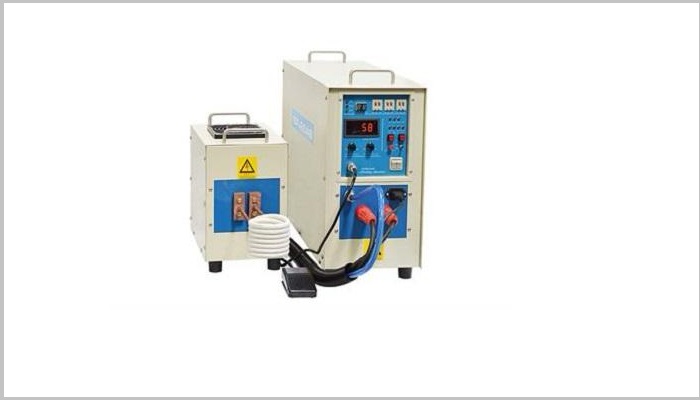Induction heating is a non-contact heating process. It uses high frequency electricity to heat materials that are electrically conductive. Since it is non-contact, the heating process does not contaminate the material being heated. It is also very efficient since the heat is actually generated inside the workpiece. This can be contrasted with other heating methods where heat is generated in a flame or heating element, which is then applied to the workpiece. For these reasons Induction Heating lends itself to some unique applications in industry.
How does Induction Heating work ?
A source of high frequency electricity is used to drive a large alternating current through a coil. This coil is known as the work coil. See the picture opposite.
The passage of current through this coil generates a very intense and rapidly changing magnetic field in the space within the work coil. The workpiece to be heated is placed within this intense alternating magnetic field.
Depending on the nature of the workpiece material, a number of things happen...
The alternating magnetic field induces a current flow in the conductive workpiece. The arrangement of the work coil and the workpiece can be thought of as an electrical transformer. The work coil is like the primary where electrical energy is fed in, and the workpiece is like a single turn secondary that is short-circuited. This causes tremendous currents to flow through the workpiece. These are known as eddy currents.
In addition to this, the high frequency used in induction heating applications gives rise to a phenomenon called skin effect. This skin effect forces the alternating current to flow in a thin layer towards the surface of the workpiece. The skin effect increases the effective resistance of the metal to the passage of the large current. Therefore it greatly increases the heating effect caused by the current induced in the workpiece.
(Although the heating due to eddy currents is desirable in this application, it is interesting to note that transformer manufacturers go to great lengths to avoid this phenomenon in their transformers. Laminated transformer cores, powdered iron cores and ferrites are all used to prevent eddy currents from flowing inside transformer cores. Inside a transformer the passage of eddy currents is highly undesirable because it causes heating of the magnetic core and represents power that is wasted.)
What is required for Induction Heating ?
In theory only 3 things are essential to implement induction heating:
A source of High Frequency electrical power,
A work coil to generate the alternating magnetic field,
An electrically conductive workpiece to be heated,
Having said this, practical induction heating systems are usually a little more complex. For example, an impedance matching network is often required between the High Frequency source and the work coil in order to ensure good power transfer. Water cooling systems are also common in high power induction heaters to remove waste heat from the work coil, its matching network and the power electronics. Finally some control electronics is usually employed to control the intensity of the heating action, and time the heating cycle to ensure consistent results. The control electronics also protects the system from being damaged by a number of adverse operating conditions. However, the basic principle of operation of any induction heater remains the same as described earlier.
What is required for Induction Heating ?
- In theory only 3 things are essential to implement induction heating:
- - A source of High Frequency electrical power,
- - A work coil to generate the alternating magnetic field,
- - An electrically conductive workpiece to be heated,
- - Having said this, practical induction heating systems are usually a little more complex. For example, an impedance matching network is often required between the High Frequency source and the work coil in order to ensure good power transfer. Water cooling systems are also common in high power induction heaters to remove waste heat from the work coil, its matching network and the power electronics. Finally some control electronics is usually employed to control the intensity of the heating action, and time the heating cycle to ensure consistent results. The control electronics also protects the system from being damaged by a number of adverse operating conditions. However, the basic principle of operation of any induction heater remains the same as described earlier.


